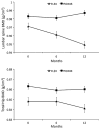Strength training stops bone loss and builds muscle in postmenopausal breast cancer survivors: a randomized, controlled trial
- PMID: 21424279
- PMCID: PMC3124708
- DOI: 10.1007/s10549-011-1444-z
Strength training stops bone loss and builds muscle in postmenopausal breast cancer survivors: a randomized, controlled trial
Erratum in
- Breast Cancer Res Treat. 2011 Jun;127(2):457
Abstract
Targeted exercise training could reduce risk factors for fracture and obesity-related diseases that increase from breast cancer treatment, but has not been sufficiently tested. We hypothesized that progressive, moderate-intensity resistance + impact training would increase or maintain hip and spine bone mass, lean mass and fat mass and reduce bone turnover compared to controls who participated in a low-intensity, non-weight bearing stretching program. We conducted a randomized, controlled trial in 106 women with early stage breast cancer who were >1 year post-radiation and/or chemotherapy, ≥ 50 years of age at diagnosis and postmenopausal, free from osteoporosis and medications for bone loss, resistance and impact exercise naïve, and cleared to exercise by a physician. Women were randomly assigned to participate in 1 year of thrice-weekly progressive, moderate-intensity resistance + impact (jump) exercise or in a similar frequency and length control program of progressive, low-intensity stretching. Primary endpoints were bone mineral density (BMD; g/cm²) of the hip and spine and whole body bone-free lean and fat mass (kg) determined by DXA and biomarkers of bone turnover-serum osteocalcin (ng/ml) and urinary deoxypyrodiniline cross-links (nmol/mmolCr). Women in the resistance + impact training program preserved BMD at the lumbar spine (0.47 vs. -2.13%; P = 0.001) compared to controls. The resistance + impact group had a smaller increase in osteocalcin (7.0 vs. 27%, P = 0.03) and a larger decrease in deoxypyrodinoline (-49.9 vs. -32.6%, P = 0.06) than controls. Increases in lean mass from resistance + impact training were greatest among women currently taking aromatase inhibitors compared to controls not on this therapy (P = 0.01). Our combined program of resistance + impact exercise reduced risk factors for fracture among postmenopausal breast cancer survivors (BCS) and may be particularly relevant for BCS on aromatase inhibitors (AIs) because of the additional benefit of exercise on muscle mass that could reduce falls.
Figures



References
-
- Horner MJ, Ries LAG, Krapcho M, Neyman N, Aminou R, Howlader N, Altekruse SF, Feuer EJ, Huang L, Mariotto A, Miller BA, Lewis DR, Eisner MP, Stinchcomb DG, Edwards BK. SEER cancer statistics review, 1975–2006. National Cancer Institute; 2009. http://seer.cancer.gov/csr/1975_2006/. Posted to the SEER web site, 2009.
-
- Chen Z, Maricic M, Bassford TL, Pettinger M, Ritenbaugh C, Lopez AM, Barad DH, Gass M, Leboff MS. Fracture risk among breast cancer survivors: results from the Women’s Health Initiative Observational Study. Arch Int Med. 2005;165(5):552–558. - PubMed
-
- Stearns V, Schneider B, Henry NL, Hayes DF, Flockhart DA. Breast cancer treatment and ovarian failure: risk factors and emerging genetic determinants. Nat Rev Cancer. 2006;6(11):886–893. - PubMed
Publication types
MeSH terms
Grants and funding
LinkOut - more resources
Full Text Sources
Medical

